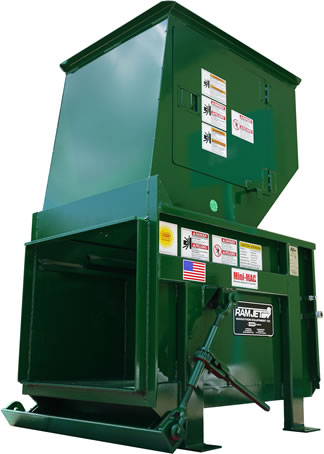High-rise facilities managers and owners are always looking for innovative ways to save money and help the environment. An often overlooked option is trash compacting and baling. With increasing landfill prices and ambitious government recycling goals, high-rise managers are looking at balers and compactors to help reduce costs and satisfy regulations.
Balers

With hand-feed hoppers, chute systems, or through-the-wall installations, Marathon Equipment Company’s Marathon Apartment Compactor is a low-cost system designed for use with small (2 yd.) containers and for installation in basements of high-rise buildings. Credit: Marathon Equipment Company
Balers are powerful machines that compress and bind waste materials into bales for convenient shipping and recycling.
A commercial baler can be used by itself, or as part of a material handling process with conveyor systems and shredders. A baler operates by feeding in loose material on the side or top, depending on the baler style, into a chamber where the waste accumulates and is compressed into a bale. The finished bale is automatically bound by wire for easy handling.
The two main types of baling machines are vertical and horizontal. With horizontal balers, loose materials are generally introduced in one end and flow to the other end where the finished bale is ejected. They take up more floor space than vertical balers, but they can handle greater load capacity and have more automated functions.
Vertical balers are often single load machines, so are perfect for buildings with limited space. They are typically loaded from the front or the top and need to be manually unloaded when the compacting and baling is complete, meaning they’re a good choice for smaller facilities.
Compactors
Compactors compress mixed waste materials into a contained area to be picked up by your waste collector.
Indoor trash compactors average from 10 to 1 compaction ratio, all the way up 25 to 1. Billing for waste services is determined by volume and how frequently it must be hauled away. With compactors, both of these factors can be greatly reduced, saving 15% to 50% of your trash disposal costs and requiring fewer disruptive visits from the trash collector.
In a high-rise, compactors work with your existing trash chute system. The waste flows into the compactors and then it’s removed by your employees. Some compactors are equipped with containers lined with heavy duty poly bags that are carted to the dumpster area, often with a wheeled cart. Other styles of compactors keep the trash in a steel wheeled front-loading container that is tipped by the trash collector.
The first step for reducing waste hauling charges is to request a breakdown of your current waste hauling costs. Most haulers send a flat-rate invoice but you’ll need to figure out what you are being charged per ‘tip’ in order to calculate the savings you’ll see from compactors. If you are being charged $40 per ‘tip’ for 3 tips per week, and you can reduce that to one tip per week, your annual savings would be over $4,000.
Fluorescent Lamp Compactors
If your facility uses fluorescent lights, you should already know that they can’t be placed in dumpsters because they contain mercury. This is a major challenge for high-rise facilities because almost all tall buildings use them.
Mercury is hazardous to the environment and your health. This is why the Environmental Protection Agency (EPA) regulates fluorescent lamp disposal. If fluorescent lamps are found in landfill sites and traced back to a facility, the building owner can be penalized with the cost of the landfill cleanup, and other fines.
In the past, facility managers were forced to repack each spent lamp into its original packing material and have them transported to a recycling facility. Today, fluorescent lamp disposal is easier and less costly than ever before.
New EPA-compliant machines are able to crush the fluorescent lamps and pack them into a 55-gallon drum. The process is fully enclosed and filtered, so that the glass, aluminum, and harmful vapors are contained. When full, the drums are picked up and transported to an EPA permitted lamp recycling facility.
For high-rise facilities managers looking for ways to reduce waste, meet recycling goals and save money, commercial balers, trash compactors, and fluorescent lamp compactors are effective solutions. All of these machines can be purchased or rented, making them affordable for every budget. This fact, combined with the labor and space savings you will achieve, make implementing balers and compactors a smart facility decision.

